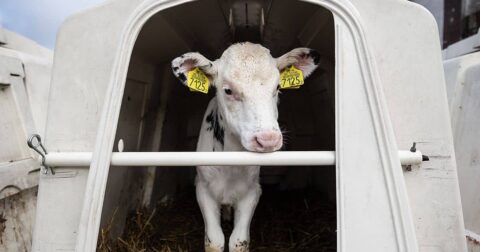Investigation
Oklahoma’s Loophole: How Tyson’s Water Use Goes Unchecked
Food•15 min read
Reported
A new investigation documents abuse and a 30 hour journey with no food or water.


Words by Sophie Kevany
Ireland’s billion-dollar dairy sector is considered one of the country’s greatest business successes, with well-known dairy brands like Kerrygold sold throughout the United States and in supermarkets around the world. But the sector has its challenges. The dairy industry requires new calves every year, and Irish dairy farmers have no space for male cattle that will never lactate, a sector-wide situation recently described as a “puzzle” by an international trade publication. A new investigation reveals what really happens to male cows once the Irish dairy industry has no use for them.
Thousands of the country’s dairy calves are exported to Dutch, Italian and Spanish farms for fattening and slaughter. Veal is a more popular dish in mainland Europe than in Ireland, with France, Italy and Germany listed as top consumers in 2014.
Because an entire sea separates the Irish dairies and mainland veal farms, the export requires a long and treacherous voyage for the animals. According to a new report, Irish calves experience “abject and continuous cruelty” on the journey from the island, says Caroline Rowley, founder and director of the NGO, Ethical Farming Ireland.
An investigation by Ireland’s national broadcaster, RTE, into the treatment of dairy calves, released in conjunction with the report, evoked condemnation on social media with one person suggesting those who care about animals switch to Irish oat milk.
In a statement, Ireland’s agriculture minister, Charlie McConalogue condemned the “shocking” practices highlighted in the RTE program.
The calves are only a few weeks old when they arrive in France but, in that time, they will have been removed from their mother, sent to an auction ring, moved to holding pens, loaded onto trucks and driven into a ferry to spend 18 hours or more at sea with patchy access to water and no food.
“Unweaned calves are dependent on milk,” explains Rowley, who led the Irish side of the NGO report’s investigation, but “they get no nutrition at all during the 30 or so hours long journey [from Ireland] to Cherbourg [in France], as they cannot be fed milk in a truck.”
Only when they reach the French mainland are they allowed to feed. But by then, the starving calves frustrate workers by spending too long drinking the milk replacement liquid. “By the time the calves reach the [French] rest stop they are starving and dehydrated, desperate for milk,” says Rowley. “The workers get very impatient with them when they won’t leave the feeding station,” she added.
Both the NGO and RTE investigations documented calves, who are “hungry, weak and confused,” being manhandled, roughly treated and beaten by workers — who themselves are under pressure to try and manage the thousands of hungry animals arriving in droves.
To ensure calves are fed in the allotted time, “workers use flat paddles to control them, sometimes hitting them with the sharp side” or, they drag the animals by their ears and tails, Rowley says. Handlers end up beating and kicking the calves to get them off the feeders and back onto the trucks. Finally, days after their journey began, they will arrive at the veal farms where they will be fattened in crates and slaughtered.
The workers’ treatment is “sickening to watch” and what’s worse Rowley added, both Irish and French authorities are ignoring reports that clearly show examples of mistreatment. “Somebody needs to take responsibility,” she says.
The report was compiled by three NGOs, Rowley’s Ethical Farming Ireland, the Dutch-based Eyes on Animals and France’s L214.
Despite extensive evidence of starving and mistreated animals provided by NGOs over the years, neither government leaders nor the shipping and livestock industries have responded. “Despite all our work, and all the proof we have given to the Irish authorities, to the European Commission and to [the ferry companies] Stena Line and Irish Ferries, nothing has changed,” says Rowley. “The suffering continues and everyone just looks the other way.”
The long and grueling export journey comes after the calves have been separated from their mothers. Despite a recent opinion from European Food Safety Authority (EFSA) scientists that calves should spend at least one day after birth with their mother, the dairy industry in Ireland and elsewhere typically separates calves from their mothers moments after birth. Most dairy calves are then fed by bottle or tube, but the process cannot replicate nursing regularly from their mother, and many may be in a weakened state by the time they travel, which can make the Irish export journey even harder to survive.
It’s not just scientific recommendations that are ignored. The new report alleges that a range of laws are also broken by Irish live calf export. In terms of rest and food, regulations stipulate that unweaned calves, unable to eat straw or hay, should be fed and rested after nine hours of transport. But the law provides the industry with a loophole: fed ‘if necessary’. After the one-hour rest, calves can be transported again for another nine hours, after which time they are then supposed to be fed and rested.
There is yet another loophole however: this one to allow for the extra travel time that comes with a sea crossing. But, according to the report, which cites a 2020 European Commission clarification, the flexibility Ireland is allowed around resting times does not extend to food, as the industry has interpreted. Despite the Commission’s clarification, the report finds many Irish calves are not rested or fed until 30 hours have passed in total.
The physical abuse documented by the investigation also violates animal welfare regulations that prohibits kicking, applying pressure to sensitive body parts and the lifting or dragging of an animal by the head, ears, horns, legs or tails.
Previously asked to respond to accusations that the live export of Irish calves breaks EU laws, the Irish government said it “ensures the transport and movement of animals operate in compliance with the legislative requirements of EU Regulation No 1 of 2005. Such movements are governed by the provisions which allow for transport by sea on regular and direct links by vehicles loaded onto vessels without unloading of the animals.” In other words, the Irish government believes the long and hungry transport — and all of the suffering it causes — is entirely legal.
Ornua, owner of the Kerrygold brand, said in an emailed statement that it “completely condemns any mistreatment of animals, which is not in keeping with the high standards of animal welfare the entire Irish farming sector works hard to maintain. We strongly welcome the Irish Department of Agriculture, Food and Marine’s decision to launch an investigation into the incidents of significant animal mistreatment and breaches of regulations raised by the RTÉ programme.”
The Irish agriculture department did not provide any immediate comments to Sentient Media on the animal abuse findings in the NGO report and RTE investigation, but news reports Tuesday said it would be launching an investigation.
“There’s no easy solution,” says Rowley, but the environmental and animal welfare harms suggest “we must stop producing so many dairy calves every year, and we must move to higher welfare systems.” Rowley points to the small number of dairy farms practicing an alternative to immediate separation. The vast majority of dairy cows, however, are raised on factory farms.
“Consumers avoid veal because it’s cruel,” says Rowley, but the animal suffering caused by calf export should alarm them too. “They should be concerned about the cruelty inherent in dairy products,” she says, adding, “particularly Irish dairy.”